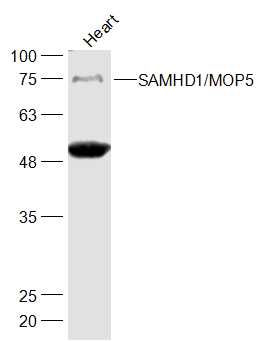产品货号 : mlR8060
英文名称 : SAMHD1/MOP5
中文名称 : 单核细胞蛋白5抗体
别 名 : DCIP; Dendritic cell derived IFNG induced protein; Dendritic cell-derived IFNG-induced protein; HD domain containing 1; HDDC1; Mg11; Monocyte protein 5; MOP 5; MOP5; OTTHUMP00000030889; SAM domain and HD domain 1; SAM domain and HD domain containing protein 1; SAM domain and HD domain-containing protein 1; SAMH1_HUMAN; Samhd1; SBBI88.
研究领域 : 细胞生物 免疫学 神经生物学 细菌及病毒
抗体来源 : Rabbit
克隆类型 : Polyclonal
交叉反应 : Human, Mouse, Rat, Cow, Horse, Sheep,
产品应用 : WB=1:500-2000 ELISA=1:500-1000 IHC-P=1:400-800 IHC-F=1:400-800 IF=1:100-500 (石蜡切片需做抗原修复)
not yet tested in other applications.
optimal dilutions/concentrations should be determined by the end user.
分 子 量 : 72kDa
细胞定位 : 细胞核
性 状 : Lyophilized or Liquid
浓 度 : 1mg/ml
免 疫 原 : KLH conjugated synthetic peptide derived from human SAMHD1/HDDC1/MOP5:256-370/626
亚 型 : IgG
纯化方法 : affinity purified by Protein A
储 存 液 : 0.01M TBS(pH7.4) with 1% BSA, 0.03% Proclin300 and 50% Glycerol.
保存条件 : Store at -20 °C for one year. Avoid repeated freeze/thaw cycles. The lyophilized antibody is stable at room temperature for at least one month and for greater than a year when kept at -20°C. When reconstituted in sterile pH 7.4 0.01M PBS or diluent of antibody the antibody is stable for at least two weeks at 2-4 °C.
PubMed : PubMed
产品介绍 : Putative nuclease involved in innate immune response by acting as a negative regulator of the cell-intrinsic antiviral response. May play a role in mediating proinflammatory responses to TNF-alpha signaling.
Tissue specificity: Expressed in heart, skeletal muscle, spleen, liver, small intestine, placenta, lung and peripheral blood leukocytes. No expression is seen in brain and thymus.
Involvement in disease:
Defects in SAMHD1 are the cause of Aicardi-Goutieres syndrome type 5 (AGS5) . A form of Aicardi-Goutieres syndrome, a genetically heterogeneous disease characterized by cerebral atrophy, leukoencephalopathy, intracranial calcifications, chronic cerebrospinal fluid (CSF) lymphocytosis, increased CSF alpha-interferon, and negative serologic investigations for common prenatal infection. Clinical features as thrombocytopenia, hepatosplenomegaly and elevated hepatic transaminases along with intermittent fever may erroneously suggest an infective process. Severe neurological dysfunctions manifest in infancy as progressive microcephaly, spasticity, dystonic posturing and profound psychomotor retardation. Death often occurs in early childhood.
Function:
Putative nuclease involved in innate immune response byacting as a negative regulator of the cell-intrinsic antiviralresponse. May play a role in mediating proinflammatory responses toTNF-alpha signaling.
Subcellular Location:
Nucleus.
Tissue Specificity:
Expressed in heart, skeletal muscle, spleen,liver, small intestine, placenta, lung and peripheral bloodleukocytes. No expression is seen in brain and thymus.
DISEASE:
Defects in SAMHD1 are the cause of Aicardi-Goutieressyndrome type 5 (AGS5) [MIM:612952]. A form of Aicardi-Goutieressyndrome, a genetically heterogeneous disease characterized bycerebral atrophy, leukoencephalopathy, intracranial calcifications,chronic cerebrospinal fluid (CSF) lymphocytosis, increased CSFalpha-interferon, and negative serologic investigations for commonprenatal infection. Clinical features as thrombocytopenia,hepatosplenomegaly and elevated hepatic transaminases along withintermittent fever may erroneously suggest an infective process.Severe neurological dysfunctions manifest in infancy as progressivemicrocephaly, spasticity, dystonic posturing and profoundpsychomotor retardation. Death often occurs in early childhood.
Defects in SAMHD1 are the cause of chilblain lupus type 2(CHBL2) [MIM:614415]. A rare cutaneous form of lupus erythematosus.Affected individuals present with painful bluish-red papular ornodular lesions of the skin in acral locations precipitated by coldand wet exposure at temperatures less than 10 degrees centigrade.
Similarity:
Belongs to the SAMHD1 family.
Contains 1 HD domain.
Contains 1 SAM (sterile alpha motif) domain.
SWISS:
Q9Y3Z3
Gene ID:
25939
Important Note:
This product as supplied is intended for research use only, not for use in human, therapeutic or diagnostic applications.
近来经科学家研究发现,SAMHD1蛋白有抑制骨髓细胞感染HIV(艾滋病病毒)的机制,SAMHD1蛋白能感应到诸如巨噬细胞和树状细胞等骨髓细胞感染到HIV-1病毒(HIV分为1型和2型,1型是目前全球流行的主要毒株,2型目前只在西非流行)和其他相关的免疫缺陷病毒,并阻止病毒副本在这些细胞内的合成,从而抑制HIV病毒感染。
产品图片












